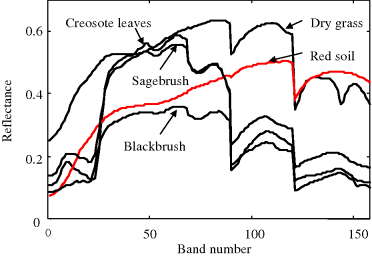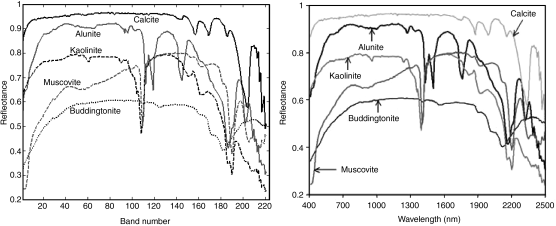1.6 Laboratory Data to be Used in This Book
Three sets of laboratory data will be used for experiments in this book, two of which were collected by the airborne visible infrared imaging spectrometer (AVIRIS) and the third one is a gas data set.
1.6.1 Laboratory Data
One data set to be used in this book is the one used in Harsanyi and Chang (1994). It is AVIRIS reflectance data shown in Figure 1.8, which has five field reflectance spectra, blackbrush, creosote leaves, dry grass, red soil, and sagebrush with spectral coverage from 0.4 to 2.5 μm and 158 bands after the water bands are removed.
Figure 1.8 Spectra of five AVIRIS reflectances. (See the color version of this figure in Color Plates section).

1.6.2 Cuprite Data
Another useful laboratory data that is available on the web site http://speclab.cr.usgs.gov/ is the reflectance spectra of five USGS ground-truth mineral spectra: alunite (A), buddingtonite (B), calcite (C), kaolinite (K), and muscovite (M) shown in Figure 1.9. Each of the five mineral spectral signatures is collected by 224 spectral bands at spectral resolution of 10 nm in the range of 0.4–2.5 μm.
Figure 1.9 Five USGS ground-truth mineral spectra.

1.6.3 NIST/EPA Gas-Phase Infrared Database
A third data set is one provided by the National Institute of Standards and ...
Get Hyperspectral Data Processing: Algorithm Design and Analysis now with the O’Reilly learning platform.
O’Reilly members experience books, live events, courses curated by job role, and more from O’Reilly and nearly 200 top publishers.

